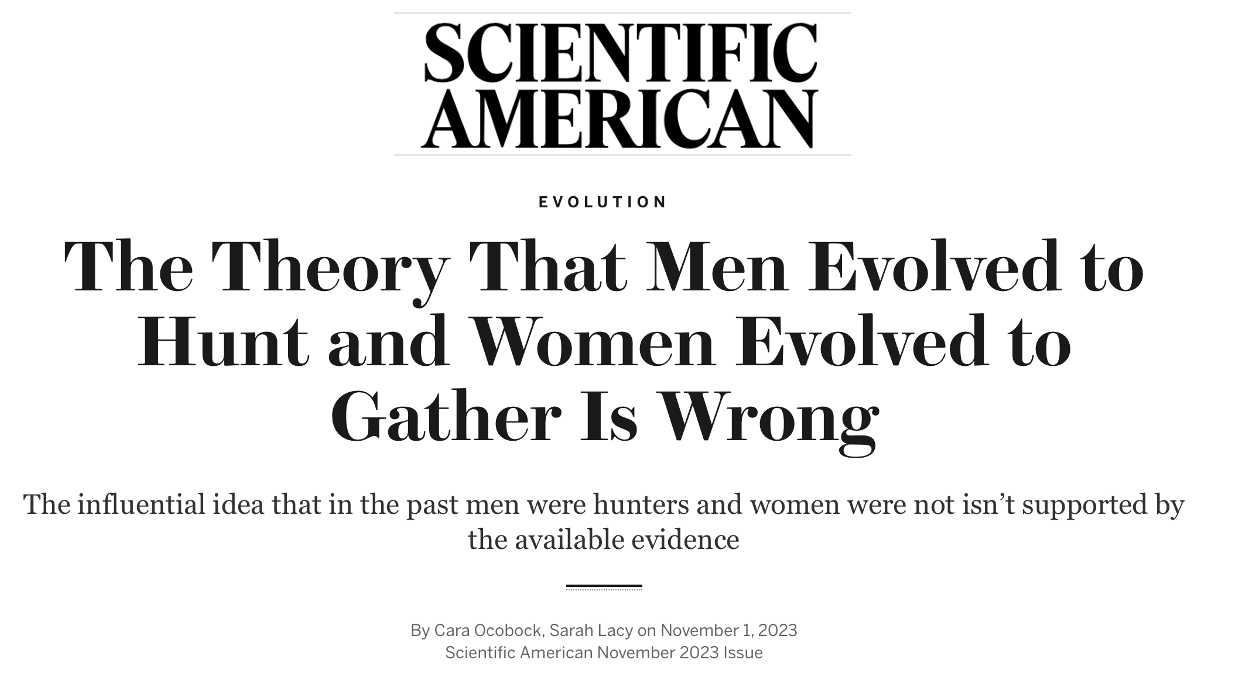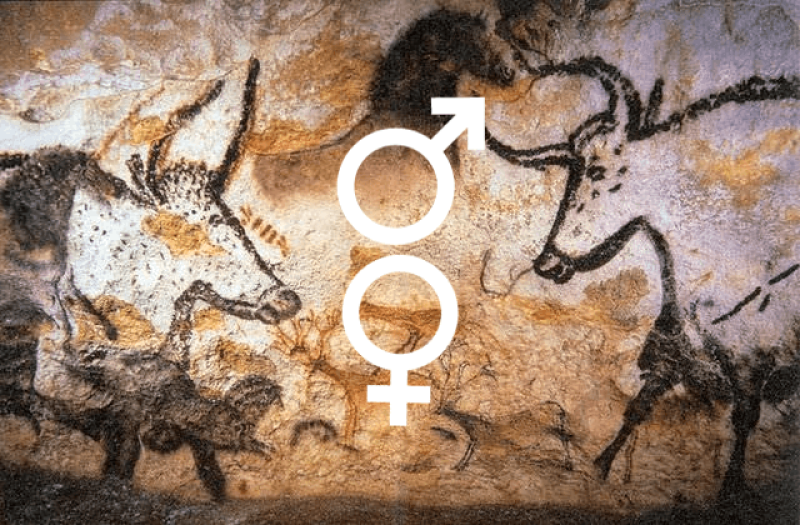
First, the idea that they’re trying to debunk is that women were “second class citizens” in early societies, forced to gather food because they were tied to childcare duties, while men did all the hunting. This is apparently an attempt to buttress the editors’ and authors’ feminism. But feminism doesn’t need buttressing with data on hunting; women’s equality is a moral proposition that doesn’t depend on observations about hunting.
Here’s their thesis:
Even if you’re not an anthropologist, you’ve probably encountered one of this field’s most influential notions, known as Man the Hunter. The theory proposes that hunting was a major driver of human evolution and that men carried this activity out to the exclusion of women. It holds that human ancestors had a division of labor, rooted in biological differences between males and females, in which males evolved to hunt and provide, and females tended to children and domestic duties. It assumes that males are physically superior to females and that pregnancy and child-rearing reduce or eliminate a female’s ability to hunt.
Man the Hunter has dominated the study of human evolution for nearly half a century and pervaded popular culture. It is represented in museum dioramas and textbook figures, Saturday morning cartoons and feature films. The thing is, it’s wrong.
…
Now when you think of “cave people,” we hope, you will imagine a mixed-sex group of hunters encircling an errant reindeer or knapping stone tools together rather than a heavy-browed man with a club over one shoulder and a trailing bride. Hunting may have been remade as a masculine activity in recent times, but for most of human history, it belonged to everyone.
But the authors’ defense of their hypothesis is deeply flawed. Here are six reasons:
1. Nobody maintains that, as the authors assert, “men carried this activity out to the exclusion of women”
2. I don’t know anyone (I may have missed some) who argues that men evolved to hunt: that is, natural selection acting on hunting behavior itself caused a difference in the sexes in their propensity to hunt.
3. The authors neglect important data casting doubt on O (Ocobock) & L’s (Lacy) conclusions.
4. The authors repeatedly imply that, in effect, males and females are equal in athletic performance, undercutting the idea that men hunted because they were athletically better equipped to hunt. But O&L’s claim of “athletic equity” is false.
The authors note that women outcompete men in some endurance sports, citing this:
Females are more regularly dominating ultra-endurance events such as the more than 260-mile Montane Spine foot race through England and Scotland, the 21-mile swim across the English Channel and the 4,300-mile Trans Am cycling race across the U.S.
…
[W]hile it may be the case … that women more often win events in archery, shooting, and badminton, in every other competitive sport I know of, men do better than women. Here is a table from Duke Law’s Center for Sports Law and Policygiving men’s and women’s best performances in 11 track and field events, as well as boys’ and girls’ best performances. In every case, not only was the record held by a man, but the best boy’s performance was better than the best women’s performance.

There is no doubt that, across all sports, men perform better than women. That’s expected because of men’s greater upper-body strength, bone strength, athletic-related physiology, and grip strength. I didn’t look up sports like tennis, but we all know that the best men outcompete the best women by a long shot, something Serena Williams has admitted.
…
Here’s a quote by O&L (my bolding)
The inequity between male and female athletes is a result not of inherent biological differences between the sexes but of biases in how they are treated in sports.
Here the authors are wading into quicksand. In fact, the entire quote is offensive to reason, for it implies that, if women were treated the same as men in sports, they would do as well. Given the differences between the sexes in morphology and physiology, such a claim flies in the face of everything we know.
5. O&L claim that both sex and gender are a spectrum, and sex is not binary
No, Scientific American: I know your editor thinks that biological sex is a spectrum, but she’s wrong and so are you. The “sex is a spectrum” mantra is another ideological tactic mistakenly used to buttress trans people or people of non-standard genders. But Mother Nature doesn’t care about ideology, and, as Luana Maroja and I showed in our paper on “The Ideological Subversion of Biology” (see point #s1 about sex), sex is binary in all animals. In humans, for example, the frequency of exceptions to the binary is only 0.018%, or 1 person in 5600. That is about the same probability of flipping a nickel and having it land on its edge, but we don’t say “heads, tail, or edge?” when calling a coin toss.
…
6. Whether or how often women hunted is irrelevant to our views of men and women
Really, why does ideology push Scientific American, and in this case O&L, to distort the facts and to leave out contrary data, when the rights of women don’t depend in the least on whether they hunted or on their relative athletic performance? … The real feminist program of equal rights and opportunities for women has nothing to do with whether they hunted as much as men in ancient (or in modern) hunter-gatherer societies.
…
In the end, we have still more evidence that Scientific American is no longer circling the drain, but is now in the drain, headed for, well, the sewers. It used to have scientists writing about their field, with no ideological bias, but now has ideologues (these authors happen to be scientist-ideologues) writing about science in a biased and misleading way.
Apparently this trend will continue, and apparently the publishers won’t do anything about it. So it goes. But those of you who want your science untainted by “progressive” ideology had best look elsewhere.
Jerry Coyne, emeritus professor of biology at the University of Chicago, is known for this critique of religion, criticism of ‘intelligent design’ theories, and as an expert on ecological and evolutionary genetics. His two most prominent books are the text Speciation and the bestselling Why Evolution Is True. Find Jerry on Twitter @Evolutionistrue
This excerpt is from an article originally posted at Why Evolution is True. Any reposting should credit both the GLP and original article.































